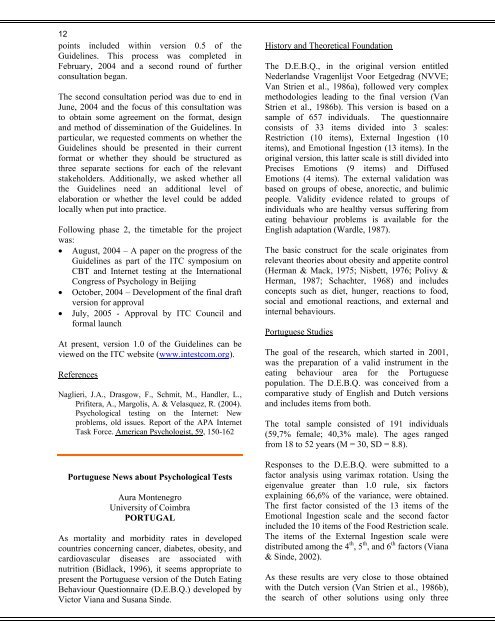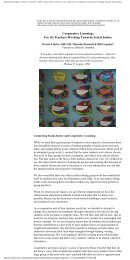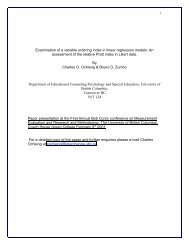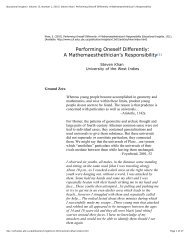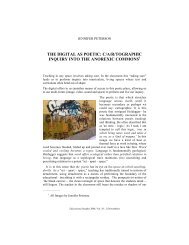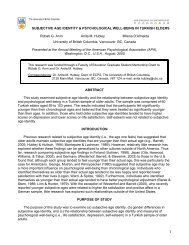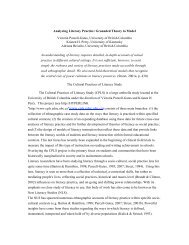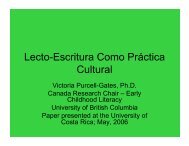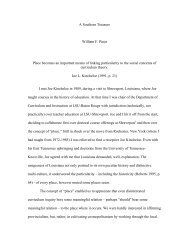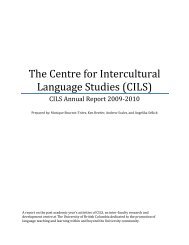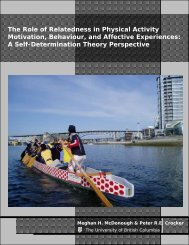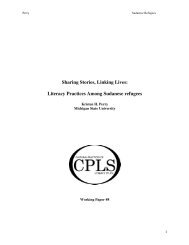TESTING INTERNATIONAL - International Test Commission
TESTING INTERNATIONAL - International Test Commission
TESTING INTERNATIONAL - International Test Commission
You also want an ePaper? Increase the reach of your titles
YUMPU automatically turns print PDFs into web optimized ePapers that Google loves.
12<br />
points included within version 0.5 of the<br />
Guidelines. This process was completed in<br />
February, 2004 and a second round of further<br />
consultation began.<br />
The second consultation period was due to end in<br />
June, 2004 and the focus of this consultation was<br />
to obtain some agreement on the format, design<br />
and method of dissemination of the Guidelines. In<br />
particular, we requested comments on whether the<br />
Guidelines should be presented in their current<br />
format or whether they should be structured as<br />
three separate sections for each of the relevant<br />
stakeholders. Additionally, we asked whether all<br />
the Guidelines need an additional level of<br />
elaboration or whether the level could be added<br />
locally when put into practice.<br />
Following phase 2, the timetable for the project<br />
was:<br />
• August, 2004 – A paper on the progress of the<br />
Guidelines as part of the ITC symposium on<br />
CBT and Internet testing at the <strong>International</strong><br />
Congress of Psychology in Beijing<br />
• October, 2004 – Development of the final draft<br />
version for approval<br />
• July, 2005 - Approval by ITC Council and<br />
formal launch<br />
At present, version 1.0 of the Guidelines can be<br />
viewed on the ITC website (www.intestcom.org).<br />
References<br />
Naglieri, J.A., Drasgow, F., Schmit, M., Handler, L.,<br />
Prifitera, A., Margolis, A. & Velasquez, R. (2004).<br />
Psychological testing on the Internet: New<br />
problems, old issues. Report of the APA Internet<br />
Task Force. American Psychologist, 59, 150-162<br />
Portuguese News about Psychological <strong>Test</strong>s<br />
Aura Montenegro<br />
University of Coimbra<br />
PORTUGAL<br />
As mortality and morbidity rates in developed<br />
countries concerning cancer, diabetes, obesity, and<br />
cardiovascular diseases are associated with<br />
nutrition (Bidlack, 1996), it seems appropriate to<br />
present the Portuguese version of the Dutch Eating<br />
Behaviour Questionnaire (D.E.B.Q.) developed by<br />
Victor Viana and Susana Sinde.<br />
History and Theoretical Foundation<br />
The D.E.B.Q., in the original version entitled<br />
Nederlandse Vragenlijst Voor Eetgedrag (NVVE;<br />
Van Strien et al., 1986a), followed very complex<br />
methodologies leading to the final version (Van<br />
Strien et al., 1986b). This version is based on a<br />
sample of 657 individuals. The questionnaire<br />
consists of 33 items divided into 3 scales:<br />
Restriction (10 items), External Ingestion (10<br />
items), and Emotional Ingestion (13 items). In the<br />
original version, this latter scale is still divided into<br />
Precises Emotions (9 items) and Diffused<br />
Emotions (4 items). The external validation was<br />
based on groups of obese, anorectic, and bulimic<br />
people. Validity evidence related to groups of<br />
individuals who are healthy versus suffering from<br />
eating behaviour problems is available for the<br />
English adaptation (Wardle, 1987).<br />
The basic construct for the scale originates from<br />
relevant theories about obesity and appetite control<br />
(Herman & Mack, 1975; Nisbett, 1976; Polivy &<br />
Herman, 1987; Schachter, 1968) and includes<br />
concepts such as diet, hunger, reactions to food,<br />
social and emotional reactions, and external and<br />
internal behaviours.<br />
Portuguese Studies<br />
The goal of the research, which started in 2001,<br />
was the preparation of a valid instrument in the<br />
eating behaviour area for the Portuguese<br />
population. The D.E.B.Q. was conceived from a<br />
comparative study of English and Dutch versions<br />
and includes items from both.<br />
The total sample consisted of 191 individuals<br />
(59,7% female; 40,3% male). The ages ranged<br />
from 18 to 52 years (M = 30, SD = 8.8).<br />
Responses to the D.E.B.Q. were submitted to a<br />
factor analysis using varimax rotation. Using the<br />
eigenvalue greater than 1.0 rule, six factors<br />
explaining 66,6% of the variance, were obtained.<br />
The first factor consisted of the 13 items of the<br />
Emotional Ingestion scale and the second factor<br />
included the 10 items of the Food Restriction scale.<br />
The items of the External Ingestion scale were<br />
distributed among the 4 th , 5 th , and 6 th factors (Viana<br />
& Sinde, 2002).<br />
As these results are very close to those obtained<br />
with the Dutch version (Van Strien et al., 1986b),<br />
the search of other solutions using only three


